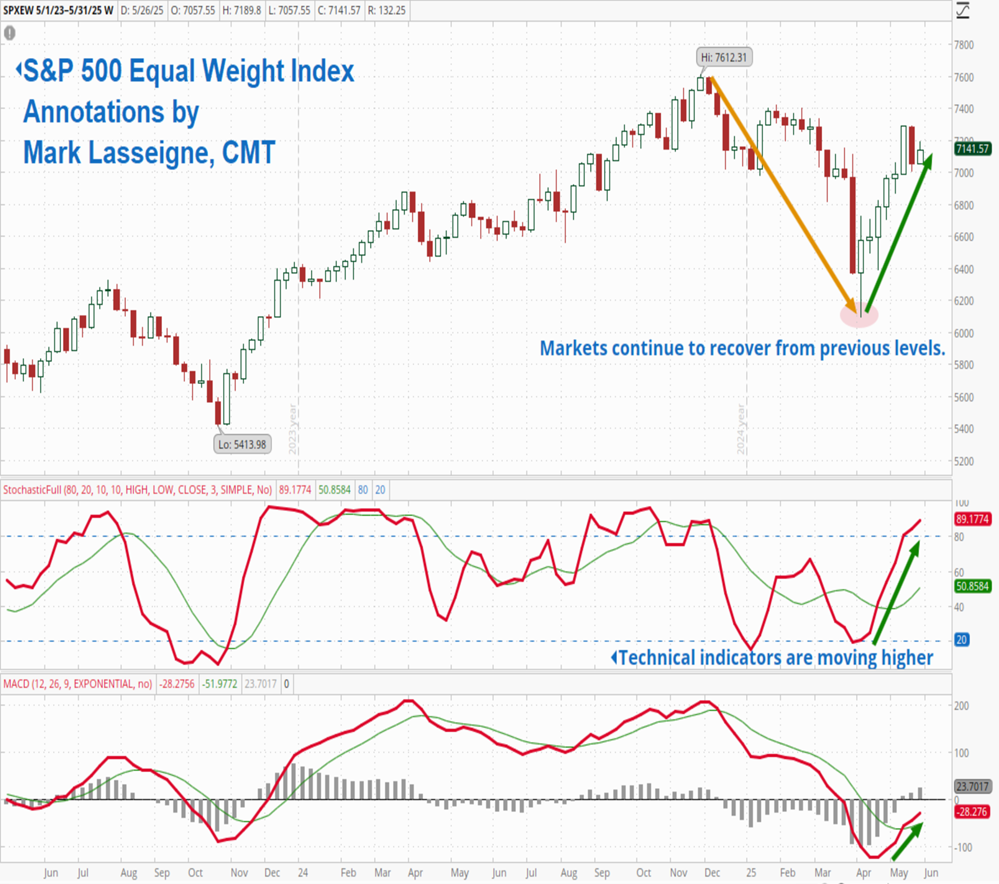Mark on the Markets
June 2025
Stocks Rebound Amid Tariff Threats
Aggressive tariff policies triggered significant market volatility amid a sharp early April selloff, which was followed by a sharp rebound when the most severe tariffs were delayed.
More recently, the market’s relatively muted reaction to tariff headlines suggests that investors are anticipating a reduction in trade tensions. At the very least, they do not foresee a prolonged escalation of tensions or a devastating trade war.

Late last month, Bespoke Group said the S&P 500 underperformed in March and April on days when trade headlines dominated. In May, however, investors generally took trade headlines in stride.
By the end of May, the Dow, the S&P 500 Index, the Nasdaq Composite, and the Russell 2000 Index of smaller companies had all risen above their levels from April 2, when the reciprocal tariffs were initially announced, according to MarketWatch data.
| Key Index Returns |
|
|
|---|---|---|
|
|
MTD % |
YTD % |
|
Dow Jones Industrial Average |
3.9 |
-0.6 |
|
NASDAQ Composite |
9.6 |
-1.0 |
|
S&P 500 Index |
6.2 |
0.5 |
|
Russell 2000 Index |
5.2 |
-7.4 |
|
MSCI World ex-USA** |
4.2 |
14.5 |
|
MSCI Emerging Markets** |
4.0 |
7.6 |
|
Bloomberg U.S. Agg Total Return |
-0.7 |
2.4 |
Source: Wall Street Journal, MSCI.com, Bloomberg, MarketWatch
MTD returns: April 30, 2025 – May 30, 2025
YTD returns: December 31, 2024 – May 30, 2025
**in U.S. dollars
Other Factors that have Contributed to the Market’s Rebound and Resiliency.
- The Treasury market has calmed down.
The early April “Liberation Day” tariffs created angst among stock market investors, which led to a selloff in bonds and rising yields (bond yields and bond prices move in opposite directions). Moreover, the dollar, which historically has been a magnet for foreign capital during heightened uncertainty, began to slip in value. The federal deficit looms in the background, but the bond market's earlier jitters have settled down, restoring a sense of stability—for now.
- Recent inflation data has been soft.
While uninspired, consumers haven’t thrown in the towel either.
- Although the Federal Reserve has been telegraphing that it is in a wait-and-see mode regarding rate cuts, significant cracks in the economy have yet to develop.
- The unemployment rate has remained steady, the economy is creating new jobs, and layoffs remain generally low, as evidenced by first-time claims for jobless benefits (Dept. of Labor data).
- First-quarter profits came in much better than expected, according to LSEG. While tariffs are generating uncertainty, forecasts provided by various firms during their respective earnings reports were generally favorable.
Our View
For the most part, economic data is backward-looking. It doesn’t definitively tell us how events will unfold. However, when market volatility increases, we continue to recommend the approaches we have discussed in the past.
Our strategy employes keeping your investments diversified, staying aware of your risk tolerance during market downturns, concentrating on your long-term objectives, and refraining from making decisions based solely on the unavoidable fluctuations in market activity. It’s an evidence-based strategy that paid off for Warren Buffett. We believe that it will help you achieve your financial goals.
Warren Buffett's philosophy on financial planning revolves around simplicity, patience, and discipline. As we have said, his approach prioritizes consistency over chasing quick profits.
Warren Buffett’s foray into the stock market began in 1941 at the age of 11 when he purchased three shares of Cities Service for $38 each, according to CNBC. The stock briefly dipped, then rebounded to $40. He sold and booked a small profit. After the sale, young Warren stood on the sidelines as he watched the stock surge, teaching him a crucial early lesson about the importance of patience and the difficulties investors encounter when deciding the right moments to buy and sell a stock.

Creating a Long-Term Financial Plan: Lessons from Warren Buffett
Warren Buffett's philosophy on financial planning revolves around simplicity, patience, and discipline. As we have said, his approach prioritizes consistency over chasing quick profits.
Let’s review some of his key principles and how we incorporate his long-term approach.
1. Invest in what you understand. Stick to your circle of competence by focusing on industries, companies, and securities you truly understand. This reduces the likelihood of mistakes in areas where your knowledge is more limited. Further, it enhances decision-making confidence.
2. Don’t get caught up in daily headlines and market volatility. Investing that feeds off emotions poses a risk to your financial goals. For example, exiting stocks during a steep market selloff usually lack a foundation in logical reasoning and is often instigated by fear, doubt, and a tendency to follow the crowd.
Buffett views market fluctuations as an opportunity to exploit rather than something to fear. Rather than reacting to short-term stock price movements, stay focused on the long-term fundamentals. Well-diversified portfolios tap into the long-term potential that the American economy has to offer.
Historically, the strength of the U.S. stock market has reflected the consistent growth of the broader economy. While we cannot predict how the stock market will perform in the next week, month, or even next year, its long-term track record is compelling.
Put simply, a growing economy lifts corporate profits. While the relationship is not perfectly linear, patience has been a virtue as rising stock prices have historically reflected this upward trend in corporate earnings.
3. Stay the course. This principle aligns with the tenet above. One of Buffett’s key principles is emotional discipline—remaining committed to a long-term strategy despite market volatility.
He warns against panic-driven selling and trend-chasing, encouraging rational patient investing.
Time and time again, he has downplayed market volatility. After a steep selloff, the primary market indexes regained a significant portion of the losses incurred during the decline in early April.
While we advise against making investment decisions solely based on market movements, if the volatility in early April caused any concerns, we’d be happy to discuss it with you.
4. Harness the power of compounding. By reinvesting dividends, investors can significantly grow their portfolios over time. Buffett credits compound interest as a major factor behind his wealth.
5. Minimize unnecessary fees and costs. We are investment managers – building and monitoring investment portfolios. We do it well, and we do it in a way that minimizes the investment product fee.
A Time to Step Back
At Berkshire Hathaway’s annual meeting last month, Warren Buffett announced he will be stepping down as CEO at the end of the year but will remain as chairman of the board. “I’m not going to sit at home and watch soap operas,” he jokingly said, but he also acknowledged that he has slowed down and shared with The Wall Street Journal how much energy his appointed successor brings to the table.
At 94, Buffett said, “There was no magic moment. How do you know the day that you become old?”
His thoughtful approach to succession and recognition that now may be the right time to step aside offers us valuable leadership lessons.
Buffett’s Core Beliefs
The legendary investor has often preached the importance of long-term investing. Buffett has long advocated patience and long-term investing over what he deems as riskier strategies, such as the glamor of day trading and the illusion of control that it generates.
“There’s a temptation for people to act far too frequently in stocks simply because they’re so liquid.” Instead, “The main thing to do is just buy into a wonderful business and just sit there with it.”
Buffett believes in buying high-quality companies and holding them for years, even decades. His famous quote, “Our favorite holding period is forever,” reflects a core principle rather than a philosophy that focuses on chasing short-term gains.
Final Remarks
In his letter last year to shareholders, Buffett was direct and unwavering in his perspective: “I can’t remember a period since March 11, 1942—the date of my first stock purchase—that I have not had a majority of my net worth in equities, U.S.-based equities. And so far, so good,” he said.
Reflecting on his earliest investment, he recalled, “The Dow Jones Industrial Average fell below 100 on that fateful day in 1942 when I pulled the trigger (purchased my first investment) … America has been a terrific country for investors.”
In his letter in 2023 he included a poignant observation: “America would have done fine without Berkshire. The reverse is not true.”
Buffett’s focus is on individual investments, and he has an enviable long-term record, but his principles are timeless, and the wisdom he has accumulated over the decades can benefit both large and smaller investors.
As Buffett wisely observed, “The stock market is designed to transfer money from the active to the patient.”
Mark on the Charts
The S&P 500 Equal Weighted Index continued to rebound in May and shown in this chart spanning two years and reporting a weekly time frame. The red and white bars show the market movement for the week, with the white bars showing when the market moves up, and the red bars showing when the market moves down. The longer the bars, the stronger the movement was for the week.
The summer months are usually a quieter time in the markets, but with all the tariff uncertainty and news headlines drumming up fears, volatility can certainly come back into the picture. For now, the uptrend seems to be leveling off, and our technical indicators are still showing strength in the market.

Timely Tax Tidbits
Tax Legislation: Trump’s “One Big Beautiful Bill”
The “One Big Beautiful Bill Act,” a 1,116-page bill passed by the House on May 22, 2025 (215-214), advances Trump’s agenda with tax cuts, spending reforms, and border security. Now in the Senate, some of the proposals include extends the 2017 Tax Cuts and Jobs Act (TCJA), higher standard deductions, bigger child credit, an estate tax easing and a new tax-advantaged savings account.

Permanent 2017 Tax Cuts:
The bill permanently extends TCJA’s individual income and estate tax cuts, preventing a 22% tax hike for the average taxpayer. This saves families approximately $1,700 annually, equivalent to nine weeks of groceries, and doubles the standard deduction, benefiting 91% of taxpayers. The estate tax exemption rises to $15 million, favoring high-net-worth individuals.
Temporary Tax Breaks:
Through 2028, the bill eliminates taxes on tips, benefiting service workers, and on overtime pay, saving workers up to $1,750 yearly. A $10,000 deduction for auto loan interest on U.S.-made vehicles expires in 2029. Seniors gain a $4,000 standard deduction increase, partially fulfilling Trump’s no-tax-on-Social-Security pledge.
Child Tax Credit and Family Support:
The Child Tax Credit rises from $2,000 to $2,500, indexed to inflation, aiding over 40 million families. “Trump Savings Accounts” provide $1,000 for newborns (2025–2029) for stock market investment. The SALT deduction cap increases to $40,000 for married couples earning up to $500,000.
Spending Cuts:
The bill cuts $1.3 trillion, including $700 billion from Medicaid via work requirements and $330 billion from student loans. It eliminates clean energy tax credits, like the $7,500 electric vehicle credit.
Border Security and Other Provisions:
It allocates $175 billion for 701 miles of border wall and additional ICE/Border Patrol agents. Tariffs aim to offset revenue losses but may raise consumer costs.
Critics of the bill claim it adds $2.4–$4T to deficit, cuts Medicaid/SNAP, favors wealthy, raises consumer costs via tariffs. Proponents say it delivers tax relief, boosts wages, strengthens border security, and fulfills campaign promises.

We’re committed to helping you experience financial contentment and peace through a plan that’s right for you, and by aligning your investment with your Christian values. It’s about understanding how you want to live and what you want to do. Whether you want to spend time with family or volunteer to make the world a better place, we help you prepare to spend your time, talents, and resources on what matters most to you.
Implementing faith-based investing begins just like any other investment
management process – we’re looking for great investments!
I hope you’ve found this review to be educational and helpful. Our goal is to be a guide to you as you run the race and keep the faith.
For surely, I know the plans I have for you, says the Lord, plans for your welfare and not for harm, to give you a future with hope. - Jeremiah 29:11
Contact Us for a Free Consultation


